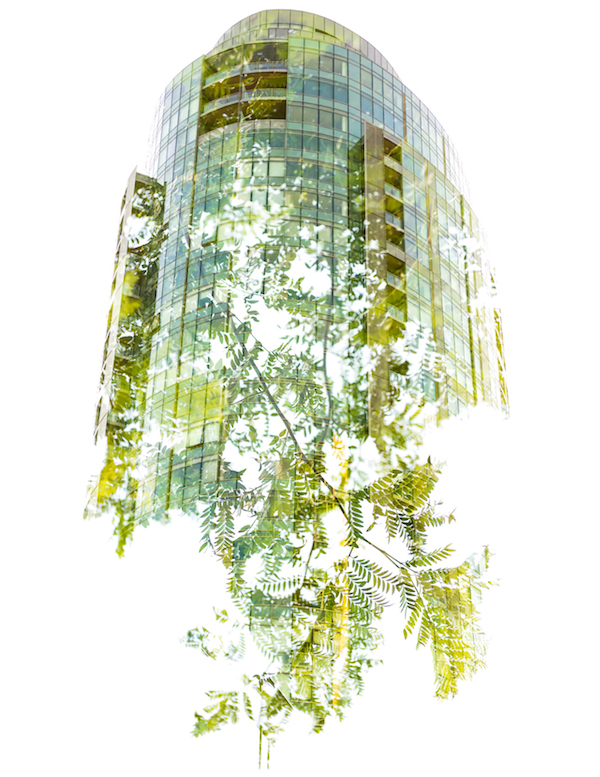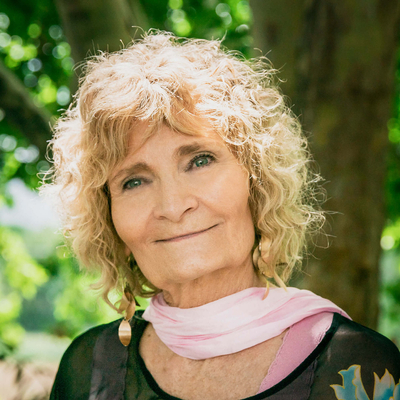The Chapel of the Holy Cross in Sedona, Arizona has always been a sacred place for me as well as for many others. It was built in the 1950s, inspired by Frank Lloyd Wright's architectural concepts of creating a harmonious relationship between a building and its natural setting. When the chapel was first constructed, it stood alone as the only human-made structure amid sandstone structures formed by wind and rain over hundreds of thousands of years. The chapel blended with the world around it, not detracting from the beauty of nature but complementing it. Decades later, the world around the chapel has changed. Though the red- and buff-colored sandstone and limestone buttes framed by evergreen and deep-blue sky still remain, there also are hundreds of private homes spread throughout the high desert surrounding this small, simple, but stunning shrine.
Years ago as a tour guide for spiritually-based tours2 I observed that most of the persons I took to the chapel experienced some form of spiritual experience while there, and many of these individuals did not necessarily consider themselves Christian or even religious. It seemed that this piece of architecture and the immediate area surrounding it provided an environment where a person could transcend human-made religions' dogma and doctrine if the individual was open to the gifts of the living spiritual forces that, to me, were obviously present in this hallowed environment. Even the commercial aspect of the chapel, the downstairs Catholic-oriented gift shop, seemed to be consecrated for those few individuals on my tours who chose to visit it. It was as if this place was set aside for all humans, regardless of their theological or philosophical leanings. It was as if the chapel and the surrounding land was indeed holy and stirred the spirit within all who, for whatever reason, were receptive to the stirring.
I always liked driving up Chapel Road, enjoying the beauty of the naturally- and human-made architecture around me, anticipating coming upon the chapel thrusting up out of the rocks it sat upon, reminding all of us of another world—a world that transcends the mundane and the material. Recently, for the first time in a couple of years, I visited the chapel. As I rounded the final corner that would give me a close-up view of the sacred space that I cherished, I was shocked to see a huge McMansion3 under construction right below the chapel, with its ornate architecture and largeness in stark contrast to the simplicity and smallness of the chapel. The McMansion seemed to jump right out at me, and I couldn't help but stop in the middle of the road and look (with horror) at what I consider a monstrosity, not in harmony with the world around it, an ostentatious intruder emanating excessive materialism. And, to top it off, there is a large sign nearby that states: “No Standing, Stopping, Parking”…Wow!
By the time I brought my attention back to the chapel I was a mess, churning with indignation and sadness, and forgot to, while still immediately below it, enjoy observing how the chapel, with its built-in prominent-yet-subtle cross, reaches up towards the heavens. When in that particular spot, I had always driven slowly, and even stopped, to remind myself of those things of eternal value. This time though I was reeling from the reminder of how awful our world can be at times with all of its decoys that lure us from the genuine thing.
To add insult to injury, as I continued to drive up the road, I passed a gate and sign that indicated the chapel and immediate area around it close exactly at 5 P.M. (These have been added in just the last few years.) Knowing that it was a couple of minutes before five, I hoped that I could at least sit for a quiet moment of contemplation in my car, looking out over the world spread below. But an employee of the place came rushing up to the car with an angry look on his face, gesturing that it was time to close and to leave immediately. Hmmm…I wonder if the living spiritual forces leave at 5 P.M. too? Do they just function 9 to 5 like the chapel hours? I wonder how many visitors to the Chapel of the Holy Cross still sense they're entering a place of sanctuary, as I and others used to several years ago.
This recent experience symbolizes for me what we humans on this world have to go through in order to reach higher levels of consciousness and reality. The chapel represents any place, activity, or attitude that lifts us up above the struggles and strivings of the material world in which we are so much a part. In order to get to the sacred space of quiet reflection, meditation, and contemplation upon things of eternal value, we have to travel through the many distractions of materialism. So often, while on the road to the chapel, we take detours, for we are drawn in by the glitter and glamour of the transitory, the unreal. There are so many signs along the way that tantalize us to take a side trip or fill us with fear so that we turn away from the call in our spirit. And often it can take us days, or weeks, or months, or years, or even lifetimes to get back on the Chapel Road.
These days the distractions are fancier, bigger, and more numerous. And now the sophistries on the road to the chapel and right next to the chapel are considered normal, acceptable, and legal! Often it's difficult to discern the difference between the real and unreal. There is no other way to the chapel but on the Chapel Road, but there are many paths that lead to that direct road. But oh how many sideshows there are along the way that can deter us from our destiny! There are parties and shows and sales going on in all of those edifices along the way. There are interesting, pretty people living in some of those houses. Who knows, maybe one of them is my next lover or employer or material benefactor. I can't just pass them by. And, there are so many side roads that can lead me to even more adventures if I would travel down them. I'll be back; I just need a little vacation or diversion, for the Chapel Road is sometimes tough to travel, even though it is a direct path to my highest destiny within divine pattern.
There is a teaching in Buddhism about the many signs in our lives that take us from our strivings to find real truth, beauty, and goodness—reality—that brings us closer to nirvana, that high state of consciousness that is our destiny to reach4. Living in a mechanistic and materialistic culture, we are trained to respond to the many signs that appear upon the paths we travel, and until we break through the signs we cannot touch reality. As long as we are caught by the signs we will miss opportunities to experience touching upon the divine that is within and around us. If we adhere to the signs, we may miss a genuine chapel experience.
Jesus taught in one of His teachings on values:
“The standard of true values must be looked for in the spiritual world and on divine levels of eternal reality. To an ascending mortal all lower and material standards must be recognized as transient, partial, and inferior.”5
How many people traveling to see Sedona's Chapel of the Holy Cross can see that the McMansion right below it is transient, partial, and inferior to the chapel, though much bigger and much more noticeable? How many will be able to get past that distraction and transcend the unwelcoming gate and unfriendly keepers of time (who may claim to be religious and spiritual) to walk into the chapel and receive the healing validation that they indeed are children of God and that there is another reality more real than the glitter and glamour that appeals to our lower natures? How many can dwell with the standard of true values, values of eternal reality?
Jesus also said in His teaching on true values that
“Unless the moral insight and the spiritual attainment of humankind are proportionately augmented, the unlimited advancement of a purely materialistic culture may eventually become a menace to civilization.”6
The results of the gross growth and mechanical regimentation around the Chapel of the Holy Cross are indicative of the menace of materialism. We can see the menace of materialism on other levels and in other places on the planet.
A Jewish theologian once stated, “We need to see each other's synagogues, churches, temples, and mosques as variations of home, refuges from a secular world.”7 Unfortunately, for many home is not a refuge but a prison or battle ground. Ideally, within divine pattern a home, temple, store, doctor's office, workplace, library, school, or any other place in which we live, worship, shop, heal, work, learn, or recreate should be sacred, somehow reminding us of the reality of truth, beauty, and goodness.
Several months ago a couple of members of Global Community Communications Alliance visited a unique and charming home and workplace in Cornville, Arizona. For them it was a sacred space, a refuge from the materialistic and fast-paced world of the dominant culture. They felt welcome to spend time roaming and exploring this place of magic that invites you to sit down to meditate and dream, play as a child, create a piece of art, read and contemplate with a good book, and share laughter and ideas in a circle of fellow human beings. This refuge is called Eliphanté and has unfolded under the loving hands of a couple since 1979 when they first acquired the property.8
The April 2005 issue of the magazine Ode alerted readers to the book, Craig Fraser: Shack Chic: Art and Innovation in South African Shack-Lands.9 Through photography Craig Fraser features people's dwellings in the shantytowns of Cape Town, South Africa. Though these people are economically impoverished and live in shacks, they have created beauty and refuge through innovative and resourceful means. In my opinion, those particular shacks function more as a refuge and sanctuary than some of the multi-million dollar mansions in more affluent neighborhoods.
When commenting on my own observations of homes that I would consider truly beautiful and a refuge, I wrote:
“I find myself contemplating appearance versus reality. I know that there is the richness and sustainability of warm, loving relationships and meaningful living going on in many ‘high-end’ homes of great beauty. But I have seen and experienced that same richness in homes which are considered shacks by many. I have also observed dullness and empty existence in every kind of house, from mansions to more modest dwellings to one-room huts.”10
Over the decades I have continued to evolve in my views and understanding of higher ways of doing things—from eating to relationships to my home and work environments. And with each new enlightening insight, I have felt blessed to discover another level of meaning, sometimes even a whole new paradigm.
As all of us are ultimately planetary brothers and sisters, children of the one God, the Universal Father, I encourage you to also begin to examine, at perhaps a deeper level, your own views, including those relating to architecture, land management and development, and all sacred spaces big and small. If we can each begin to make personal change—be in it attitudes, mindsets, or very tangible physical environments—I believe we will see our world metamorphose into something more beautiful than we ever imagined!
1 I use the term architectonics in this article in a broad multi-layered sense with all three definitions of the term (according to Merriam Webster's Collegiate Dictionary) in mind: 1. the science of architecture, 2. the unifying structural design of something, 3. the system of structure.
2 For more information about the spiritually-based tours of Spirit Steps Tours, call (800) 728-4562 or (520) 398-2655 or visit www.spiritsteps.org
3 McMansion is a loosely defined term that entered the lexicon only in approximately the last ten years. The word has evolved to mean “a largely opulent house, especially a new house that has a size and style that doesn't fit in with the surrounding homes.” McMansions have environmental groups increasingly worried about the impact large homes have on communities. For more information see www.explore/architecture.com/architecture/M/McMansion.http://en.wikipedia.org/wiki/McMansion
4 For a good explanation of Buddhist teachings, see The Heart of the Buddha's Teachings by Thich Nhat Hanh.
5 The URANTIA Book, p. 1457
6 Ibid.
7 “Leap of Faith” (An interview with Yossi Klein Halveri), The Sun, March 2005.
8 Flagstaff, Arizona-based newsmagazine The Noise has an article about Eliphanté in its April 2005 issue. Also check out www.eliphante.org.
9” Shack Chic,” pp. 48-49, Ode, April 2005. For further information about Ode, see the “Watcha Reading'?” column in the February/March 2005 issue of Alternative Voice.
10 “Sustainable Living: How Do We Achieve It? Where Do We Begin?” Alternative Voice, May/June 2003.


